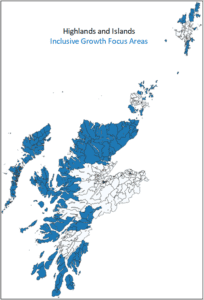Inclusive Growth Weighting
Economic disadvantage and opportunity vary by location within any region and such variation is particularly pronounced within the Highlands and Islands. Representing over half of Scotland’s land mass, including most of the nations’ mountainous areas and over 90 inhabited islands, the sparsely populated Highlands and Islands region is host to a patchwork of economic challenges. Rurality and peripherality drive disadvantage and the topography of the region creates barriers and challenges for service delivery. Wages are typically lower in the region than in the rest of Scotland and being employed in multiple jobs or part-time roles is common. Disadvantage is exacerbated by a much higher cost of living for households in parts of the region, particularly in terms of transport and fuel costs.
Highlands and Islands Enterprise (HIE), responsible for delivering economic and community development across the region, must consider significant geographic inequalities when prioritising its support. Recognising the disparities within the region and the need to address challenges and opportunities within individual communities and places with distinct characteristics, the agency identified the requirement for a tool that would assist in:
• prioritising investment by the degree to which different potential interventions contribute to inclusive growth
• evaluation of the spread and profile of the impact of interventions in terms of inclusivity
• articulation of HIE’s overall contribution to inclusive growth and the wellbeing economy within any given period.
In line with these imperatives, a systematic approach to the measurement of HIE’s contribution to inclusive growth was designed, building on work undertaken by the agency in collaboration with the James Hutton Institute (JHI) in 2020.
The HIE/JHI study identified areas sharing similar inclusive growth challenges and opportunities, successfully describing the nature of disadvantage using a framework of 36 indicators pertinent to the measurement of inclusive growth. Whilst this work successfully described the nature of disadvantage in different parts of the region, further work was needed to measure the scale of disadvantage.
Two tools were developed to assess geographically varying economic conditions and establish how HIE’s investment and economic output could be weighted according to the extent to which it contributed to inclusive growth.
The first tool focuses on economic welfare, performance and conditions to support economic growth and combines six indicators to derive a score for each of 34 geographic areas that make up the region.
• Change in working age population (16 – 64) over a ten-year period
• Dependency ratio: Ratio of dependants aged 0-15 and 65+ compared to working age population aged 16-64
• Employment rate
• Income deprivation (SIMD)
• Physical remoteness, using the Scottish Government 8-fold Urban-Rural Classification
• Productivity (GVA per employee)
The second tool is based on cost-adjusted household income. Income is first ‘equivalised’ to account for differences in household composition. It then looks at household costs relating to food, clothing, household goods, travel, social participation, fuel/energy and housing. Median household income in any given geographic area is then adjusted according to the local cost of living to arrive at a score for that area.
The score from the first tool is used to adjust or ‘weight’ the value of HIE’s economic output and the score from the second tool is used to adjust the value of project investment. The lower the score, the greater the disadvantage and therefore the greater the adjustment.
The adjusted value of the investment or output enables decision-makers to understand each intervention’s current or potential contribution to inclusive growth.
HIE’s overall activity can be contextualised and assessed in terms of inclusive growth by using the combined value of all adjusted values across all interventions and comparing these with the unadjusted values.
Areas that attract a score below the median using either of the tools are identified as ‘Inclusive Growth Focus Areas’. These areas represent 33% of the population of the Highlands and Islands. This classification supports area policy development and prioritisation, helping to ensure that HIE uses its resources in the optimum manner to promote inclusive economic growth.
For further information, please contact Andy Sarjeant at andrew.sarjeant@hient.co.uk

